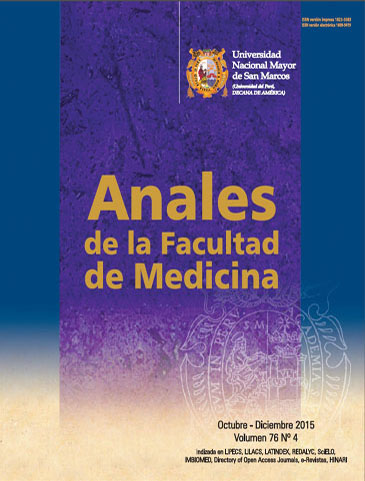Human papillomavirus (HPV) knowledge and prevention practices among Sierra Sur, Oaxaca college students
DOI:
https://doi.org/10.15381/anales.v76i4.11406Keywords:
Risk-taking, Sexually transmitted diseases, Sex education.Abstract
Introduction. Human papillomavirus (HPV) causes the world’s most important sexually transmitted infection and is considered the main agent for cervical cancer. Youngsters are most vulnerable as they usually begin sexual relations without protection. Objectives. To describe students’ knowledge of human papillomavirus infection prevention at Sierra Sur, Oaxaca University. Design. Quantitative, descriptive cross-sectional study. Place. Sierra Sur, Oaxaca, Mexico. Participants. University students from different programs who reported to have an active sexual life. Interventions. A closed response questionnaire was constructed and applied to the students by self-administration. Main outcome measures. The instrument was divided into sections including sociodemographic, academic and sexual aspects, knowledge about HPV and prevention practices. Results. Male participants became sexually active earlier than women (x2 = 25.7, p = 0.048), had more partners (x2 = 34.09, p = 0.002), and about half of them did not use condom during sex. They were unaware that the virus is associated with cervical cancer (x2 = 17.5, p <0.001) and may cause cancer in men (x2 = 0.09, p = 0.760). They did not know the main clinical manifestations of the disease (x2 = 1.7, p = 0.415). Students of the health sciences had some knowledge on HPV diagnosis. Age did not affect knowledge on the virus. Conclusions. This study revealed that most students do not know the clinical features, management and treatment of the HPV infection and as a consequence are unaware of the importance of the transmission. It is necessary to give more importance to the sex education of university students and to raise awareness of the impact of the HPV infection, by informing about the transmission mechanisms, prevention methods, and clinical manifestations.Downloads
Published
2015-12-31
Issue
Section
Artículo Original
License
Copyright (c) 2015 Gisela Mayra Bustamante Ramos, Abisai Martínez-Sánchez, Inés Tenahua-Quitl, Concepción Jiménez, Yarely López Mendoza

This work is licensed under a Creative Commons Attribution-NonCommercial-ShareAlike 4.0 International License.
Those authors who have publications with this magazine accept the following terms:
- Authors will retain their copyrights and guarantee the journal the right of first publication of their work, which will be simultaneously subject to Creative Commons Attribution License that allows third parties to share the work as long as its author and its first publication this magazine are indicated.
- Authors may adopt other non-exclusive licensing agreements for the distribution of the version of the published work (eg, deposit it in an institutional electronic file or publish it in a monographic volume) provided that the initial publication in this magazine is indicated.
- Authors are allowed and recommended to disseminate their work over the Internet (eg: in institutional telematic archives or on their website) before and during the submission process, which It can produce interesting exchanges and increase quotes from the published work. (See El efecto del acceso abierto ).
How to Cite
1.
Bustamante Ramos GM, Martínez-Sánchez A, Tenahua-Quitl I, Jiménez C, López Mendoza Y. Human papillomavirus (HPV) knowledge and prevention practices among Sierra Sur, Oaxaca college students. An Fac med [Internet]. 2015 Dec. 31 [cited 2024 Jul. 3];76(4):369-76. Available from: https://revistasinvestigacion.unmsm.edu.pe/index.php/anales/article/view/11406















